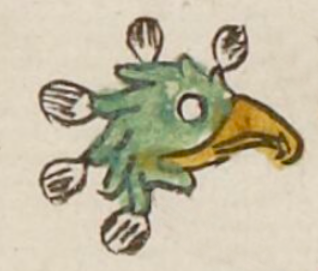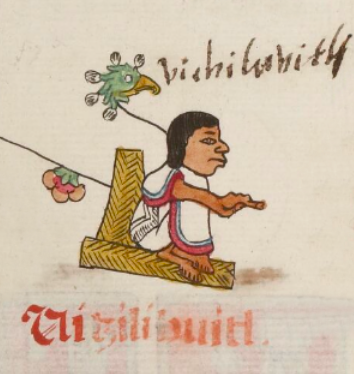Huitzilihuitl (TR30r)
This compound glyph for the personal name Huitzilihuitl includes the head of which is apparently meant to be a hummingbird (huitzilin), despite having a hooked beak. (Hummingbird glyphs show a long, pointed beak.) It is shown in profile looking toward the viewer's right. The feathers (ihuitl) at the back of its head are spiky, and around the perimeter of its head are five, small, white, round feathers, possibly down feathers. Its eye is white, as though open. The overall effect of the name is Hummingbird-Feathers.
Stephanie Wood
Huitzilihuitl was the name of the second ruler of Tenochtitlan. The dates of his rule are inconsisted across various records. According to Chimalpahin, his rule spanned from 1390 to 1415. The Codex Aubin gives 1396 to 1417, and the Codex Chimalpopoca gives 1403 to 1417.
Stephanie Wood
ca. 1550–1563
Jeff Haskett-Wood
rulers, gobernadores, gobernantes, colibríes, hummingbirds, feathers, plumas, nombres famosos, nombres de hombres

huitzil(in), hummingbird, https://nahuatl.wired-humanities.org/content/huitzilin
ihui(tl), feather, https://nahuatl.wired-humanities.org/content/ihuitl
Las Plumas del Colibrí
Stephanie Wood
Telleriano-Remensis Codex, folio 30 recto, MS Mexicain 385, Gallica digital collection, https://gallica.bnf.fr/ark:/12148/btv1b8458267s/f85.item.zoom
The non-commercial reuse of images from the Bibliothèque nationale de France is free as long as the user is in compliance with the legislation in force and provides the citation: “Source gallica.bnf.fr / Bibliothèque nationale de France” or “Source gallica.bnf.fr / BnF.”










